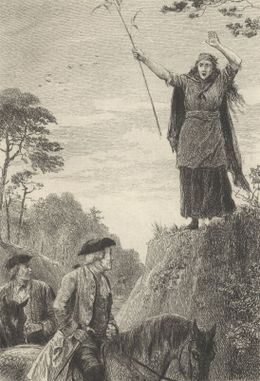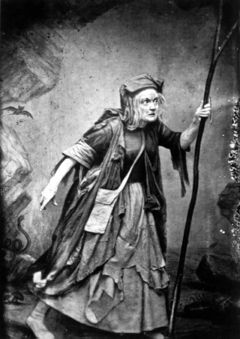Annotation:Meg Merrilies
Back to Meg Merrilies
MEG MERRILIES/MERRILEES'. English, Scottish, Shetland; Country Dance Tune, Hornpipe or Reel. G Major (Dixon, Hardings): A Major (Athole, Honeyman, Howe, Hunter, Kerr, Lees). Standard tuning (fiddle). AB (Athole): AAB (Kerr): AABB (Honeyman, Howe, Hunter, Lees): AABB' (Hardings): AABBCCDDEEAABB (Dixon). Meg Merrilies is the name of a Scottish country dance, commonly taught by dancing masters in the 19th century. Elias Howe (c. 1867), however, classifies it as an "English Country Dance." The Shetland variant has a distinct character that distinguishes it from the Scottish (Cooke). Dixon (1995) prints the melody with variation sets by Robert Whinham (1814-1893), a musician, teacher, composer, dancing master and fiddler originally from Morpeth, Northumberland.
However, the title Meg Merrilies derives from the name of a character in Sir Walter Scott's Guy Mannering [1] and, separately, the subject of a poem by John Keats (1795–1821) that begins:

Old Meg she was a Gipsy,
And liv'd upon the Moors:
Her bed it was the brown heath turf,
And her house was out of doors.
Her apples were swart blackberries,
Her currants pods o' broom;
Her wine was dew of the wild white rose,
Her book a churchyard tomb.

The characters in both works were based on a person named Jean Gordon, a mid-18th century inhabitant of the village of Kirk Yetholm in the Cheviot Hills, and wife of the King of the Gypsies, Patrick (sometimes "Johnnie") Faa. The character is that of a gypsy, or a half-mad seeress. Guy Mannering was adapted for the stage and the character of Meg was memorably played by the American actress Charlotte Cushman (1816-1876) in New York.
Source for notated version: the manuscript of piper and fiddler Tom Armstrong of Hindley Steele, Northumberland, c. 1850 [Dixon].
Printed sources: Dixon (Remember Me), 1995; p. 62. Hamilton's Universal Tune Book, 1844; p. 36. Hardings All-Round Collection, 1905; No. 74, p. 23. Honeyman (Strathspey, Reel and Hornpipe Tutor), 1898; p. 45 (appears as "Meg Merrilees' Hornpipe"). Howe (1000 Jigs and Reels), c. 1867; p. 71. Hunter (Fiddle Music of Scotland), 1988; No. 315. Kerr (Merry Melodies, vol. 1), c. 1880; No. 1, p. 23. Laybourn (Köhler’s Violin Repository vol. 2), 1881-1885, p. 156. J. Kenyon Lees (Balmoral Reel Book), Glasgow, 1910; p. 27. Stewart-Robertson (The Athole Collection), 1884; p. 142.
Recorded sources:
